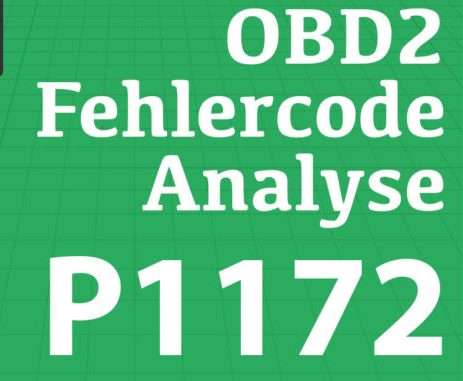
P1172 (Volkswagen, Audi, Skoda, Seat) Throttle position sensor 2 - input signal too low
Content
P1172 – OBD-II Trouble Code Technical Description
Trouble code P1172 indicates that the input signal level of the throttle position sensor 2 is too low in Volkswagen, Audi, Skoda, Seat vehicles.
What does the fault code mean P1172?
Trouble code P1172 indicates that the input signal level of the throttle position sensor 2 is too low in Volkswagen, Audi, Skoda, Seat vehicles. This means that the engine management system has detected that the signal from throttle position sensor 2 is below acceptable limits.

Possible reasons
Some possible reasons for the P1172 trouble code:
- Faulty throttle position sensor (TPS): If the TPS sensor is not functioning properly or has failed, it can cause excessive signal levels and cause P1172.
- Damaged wiring or connections: Problems with the wiring or connectors associated with the TPS sensor can cause incorrect signals and lead to P1172.
- Engine control module (ECU) malfunction: In some cases, the problem may be due to a malfunction of the engine control module, which processes the signals from the TPS sensor.
- Throttle problems: If the throttle body is stuck, damaged, or otherwise malfunctioning, this may result in erroneous data from the throttle position sensor and a P1172 code.
- Problems with the vacuum system: Problems with the vacuum system, such as leaks or blockages, can also cause the throttle valve to malfunction and cause the P1172 code to appear.
These are just some of the possible causes, and an accurate diagnosis requires additional tests and checks to determine the correct source of the problem.
What are the symptoms of a fault code? P1172?
Symptoms for DTC P1172 may include the following:
- Loss of engine power: Too much or too little air and fuel can cause loss of engine power.
- Unstable engine performance: An improper fuel/air mixture can cause engine roughness, manifested by shuddering, rough idling, or even cylinder misfire.
- Uneven engine idling: There may be jumps in engine speed at idle due to an unstable mixture of fuel and air.
- Difficulty starting the engine: Incorrect fuel/air ratio can make the engine difficult to start, especially in cold weather.
- Increased fuel consumption: An incorrect mixture can lead to increased fuel consumption, which will be noticeable at gas stations.
- Increased emissions of harmful substances: An incorrect mixture can also lead to increased emissions of harmful substances in the exhaust, which can lead to problems with environmental standards and vehicle maintenance.
These symptoms may occur to varying degrees depending on the specific problem and the condition of the engine.
How to diagnose a fault code P1172?
The following steps are recommended to diagnose DTC P1172:
- Checking the error code: Use an OBD-II scanner to read the P1172 fault code from the Engine Control Module. Write down the code and any additional information that the scanner may provide.
- Checking wiring and connections: Inspect the wiring and connectors associated with the throttle position sensor (TPS) and engine control module (ECU). Make sure the wiring is intact and connections are secure.
- Checking the TPS Sensor: Check TPS sensor operation using a multimeter or specialized sensor testing equipment. Verify that the signals coming from the TPS sensor meet the manufacturer's specifications.
- Checking the throttle valve: Check the condition and operation of the throttle valve. Make sure it moves freely and doesn't get stuck. The throttle body may need to be cleaned or replaced if it is damaged or coated.
- Engine Control Module (ECU) Diagnostics: Test and diagnose the engine control module using specialized automotive diagnostic equipment. Check it for errors and malfunctions.
- Re-checking the error code: After performing all necessary checks and repairs, read the P1172 code again using an OBD-II scanner. If all problems are resolved, the error code should be deleted from the memory of the engine control module.
If you have difficulty or confusion in diagnosing the P1172 trouble code, it is recommended that you contact a qualified auto mechanic or auto repair shop for professional assistance.
Diagnostic errors
When diagnosing DTC P1172, the following errors may occur:
- Misinterpretation of data: An error may result from misunderstanding the data received from a scanner or other diagnostic equipment. This may lead to misinterpretation of the cause of the error and incorrect repair.
- Skipping important diagnostic steps: The error may involve missing an important diagnostic step, such as not checking the wiring sufficiently or not checking the TPS sensor correctly. This may result in missing the real cause of the error.
- Hardware malfunction: The error may be a malfunction of the diagnostic equipment used, such as an OBD-II scanner or multimeter. Incorrect or faulty equipment may produce incorrect results and lead to incorrect diagnosis.
- Incorrect problem fix: If the cause of the error is not correctly identified or not completely corrected, it may cause DTC P1172 to reappear after repair work is performed.
- Software problems: Misinterpretation of data or errors in vehicle software or diagnostic equipment can also cause diagnostic errors.
To prevent these errors, it is recommended to carefully follow diagnostic procedures, use reliable equipment, and double check the data obtained.
How serious is the fault code? P1172?
The severity of the P1172 trouble code can vary depending on the specific cause that caused it, as well as the condition of the vehicle. In general, P1172 indicates problems with the throttle position sensor (TPS) or its signal, which can affect engine performance and efficiency.
Although P1172 is not critical in itself, ignoring it can have serious consequences for the performance of the engine and fuel system. If the fuel/air mixture is not adjusted correctly due to problems with the TPS sensor, it can result in loss of engine power, increased fuel consumption, and increased emissions.
Moreover, if the problem remains unresolved, it can cause additional damage to the engine management system and require more extensive and costly repair work.
Therefore, it is important to pay close attention to the P1172 trouble code and promptly diagnose and repair the problem to ensure the normal and safe operation of your vehicle.
What repair will help eliminate the code? P1172?
Troubleshooting DTC P1172 depends on the specific cause that caused it. Here are some possible measures that may help resolve the problem:
- Checking and replacing the throttle position sensor (TPS): If the TPS sensor fails or does not work correctly, it should be replaced with a new one and the system should be checked after that.
- Checking wiring and connectors: Check the condition of the wiring and connections associated with the TPS sensor. Damaged wires or connectors may need to be cleaned or replaced.
- Checking and cleaning the throttle valve: Check the condition and operation of the throttle valve. Clean it from dirt and check if it moves freely. If necessary, replace or adjust the throttle valve.
- Engine Control Module (ECU) Diagnostics: Test and diagnose the engine control module. If the problem persists after replacing the TPS sensor and checking the wiring, the problem may be with the ECU itself and will need to be replaced or repaired.
- Updating the software: Sometimes problems with error codes can be related to the engine control module software. Updating the ECU software can help resolve such problems.
It is important to note that doing this work yourself can be difficult and requires certain skills and tools. Therefore, if you do not have experience in car repairs, it is recommended that you contact a qualified auto mechanic or auto repair shop for professional assistance.

